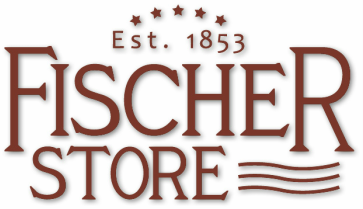|
In 1849, Hermann Fischer traveled from Germany and settled on 75 acres near Seguin, Texas, along Geronimo Creek. His brother Otto arrived in 1852, purchasing 100 acres nearby. The brothers lived and farmed there until 1853, when they filed a joint claim on 160 acres in northern Comal County. The new land was more suitable for livestock ranching than farming, and their joint brand was recorded in Comal County Marks and Brands in 1854. The brothers were the first settlers in the area, with no neighbors for a fifteen-mile radius. |
|
The Fischers began raising cattle and cultivating a few fields. At that time, the country was still open range; their cattle roamed from the Pedernales River to the Guadalupe River. Ranching was a difficult way to make a living, dependent on weather and vulnerable to rustlers and predators. By 1866, Hermann had sold his cattle and was using his banking education to run a mercantile business. The store did well and grew quickly, expanding twice to increasingly larger buildings by 1902. Over the years, the business grew to include a saloon, post office, cotton gin, grain elevator and grist mill. |
|
Otto sold Hermann most of his share of the original joint 160 acres, and went on to purchase a great deal more land on his own. Eventually he owned 2,000 acres, raising horses, cattle and sheep. He became known as “Stock” Fischer, while Hermann became “Store” Fischer. Although the focus was on the mercantile aspect, the ranch was still part of Hermann’s business. Along with his son, Hermann II, the Fischers bought and sold many parcels of land over the years, including some that were given in lieu of payment on store goods during the Depression. Ultimately this added to the original 160 acres. After the early failed attempt at raising cattle, the ranch was mainly used to raise draft and saddle horses. In the 1920s, Hermann III introduced the first Angora goats to the ranch. He brought in about 60 head from the Fredericksburg area, but they all turned out to be muttons and unable to breed. During the Depression, the family sold quite a few of them for meat. Later, some nannies were bought from Henrich Sites, near Wimberley, to have a brood herd. Mohair prices rose, and stayed very high until the rise of synthetic fibers in the 1960s. As the bottom dropped out of the mohair market, the last goats were sold in 1971. |
|
There were always a few beef and milk cattle on the ranch, both for the family’s use and to occasionally sell to neighbors. By the early 1980s, cattle were mostly Herefords because they didn’t require as much care. Then in the mid- 1990s, the family began switching to Brangus cattle. Able to range further from water, they were well-suited to dry climate and rough terrain. In 2004, the Hermann Fischer Ranch was recognized by the Texas Department of Agriculture Family Land Heritage for 150 years of continuous agricultural operation by the same family. |





